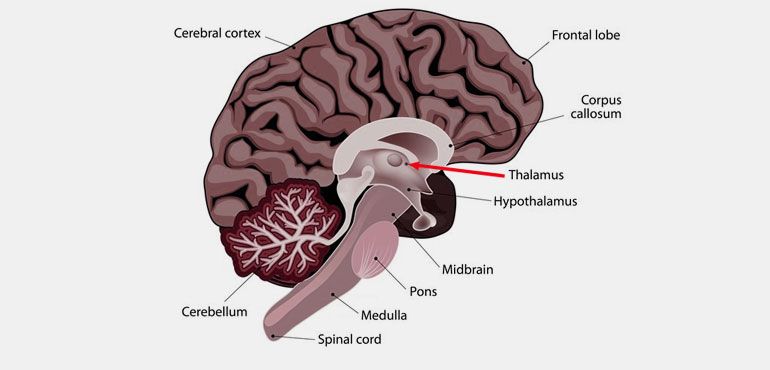What is Thalamus Responsible for?

- Why do you call the thalamus the ‘gateway’ to the cerebral cortex?
- What is the structural importance of the thalamus in the brain?
- Is the role of the thalamus as a relation active or passive?
- How do you make perception out of a sensation?
S. Murray Sherman and Ray W. Guillery (2001) in their book “Exploring the Thalamus”highlighted the role of the thalamus as the ‘gateway’ to the cortex. According to them, it is the major relay station to your cerebral cortex.
Everything you know about yourself or the world around is owed to the messages passing through the thalamus.
Sandwiched between the outer layer of the cerebrum – the cerebral cortex – and the midbrain, the thalamus makes one of the three parts of the diencephalon, with the other two being the hypothalamus, and the third ventricle.
Did you know the diencephalon is also called the interbrain or the between brain?
In the book “The Thalamus”, Edward G. Jones (2012) gave the tripartite division of the thalamus. That is, it consists of three parts, viz. the dorsal, ventral, and epithalamus. Among these three divisions, it is only the dorsal thalamus which both sends to receives fibres from the cerebral cortex and striatum.
The ventral division only receives fibres from both the sides, i.e. the cerebral cortex and the striatum. The third division, the epithalamus, neither sends nor receives axons from either side.
Here striatum or corpus striatum is a crucial component of the motor and reward system, which coordinates multiple aspects of cognition such as motivation, reward perception, reinforcement, and decision-making.
Functions of Thalamus in the Brain:
Though making an insignificant contribution to the overall brain mass, the thalamus plays an important role in getting an understanding of the world around.
The latest research refutes the previous belief about the thalamus that it only passively relays the sensory information to the cortex.
This part of the brain has now been acknowledged as actively regulating the information that it transmits to the cortical areas.
Below are some of the main functions of thalamus in the brain:
A Connecting Link:
Structurally, the thalamus makes a connecting link between the cerebral cortex and other parts of the brain and the spinal cord. The sensory information collected from different sensory organs passes through this part of the brain to reach the cerebral cortex.
A Relay Station:
Chapter on “Diencephalon: Thalamus” in “The Brain and Behaviour: An Introduction to Behavioural Neuroanatomy” (David L. Clark et al, 2010) highlights the role of the thalamus as a relay station.
It is made up of several nuclei – where a nucleus is a cluster of neurons – and acts as a principal relay station for the sensory information going towards the cerebral cortex for processing and generation of a response signal.
Waking Behaviour:
Did you know the thalamus plays a dynamic and interesting role in regulating your normal waking behaviour? It feeds to the cerebral cortex a changeable relay of information.
In this way, the nature of relayed information can be adjusted corresponding to the changing behavioural demands.
Another interesting role of the thalamus in regulating the waking behaviour is that it not only relays peripheral information to the cortex but also plays a vital role in further processing of this information in the cortical areas.
Cognition:
Cognition is a process by which you develop an understanding of the world around you. It is believed to be processed in the cerebral cortex. Recently, the researchers have also acknowledged the role of the thalamus in the functioning of the cortex and higher-order cognition ranging from learning to memory.
Role in Memory:
Among the cognitive functions of the thalamus, memory was probably the first to be formally associated with this part of the brain. The mediodorsal thalamus and the anterior thalamic nucleiare both regarded as playing a role in this connection.
According to the findings of Aggleton and Brown (1999), the mediodorsal thalamus supports familiarity-based memory while the anterior thalamic nuclei support recollective memory.
Learning:
Learning is an important cognitive function formally associated with the thalamus. It not only plays a role in initial learning but also keeps on monitoring and updating current information within a changing situation.
